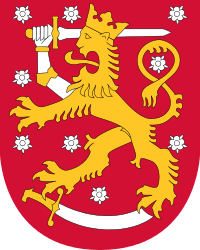Christian Workers' Union of Finland
 |
| This article is part of a series on the politics and government of Finland |
|
Legislative
|
|
|
The Christian Workers' Union of Finland (Finnish: Suomen Kristillisen Työväen Liitto; Swedish: Finlands kristliga arbetarförbund, abbreviated SKrTL) was a political party in Finland. The party was led by the industrial worker Antti Kaarne until 1918.[1]
History
The party was founded in 1906, in the aftermath of the 1905 general strike. It had a radical Christian socialist profile. The program of the party was largely similar as that of the Social Democratic Party of Finland, but it could not reconcile with the atheism of the Social Democrats.[1] The motto of the party was to "...on the basis of the Christian faith, liberate our people from the oppression of capital."[2]
In the early years of the party, two distinct tendencies were active amongst its membership; a tendency dominated by priests that hoped that the party would enable them to win allies in the struggle against atheism, and a tendency led by Kaarne that sought to implement social reforms on the basis of Christian principles. Soon, however, the clergy-based faction was marginalized in the competition over the orientation of the party.[1]
In the 1907 elections the party won two seats in the Eduskunta. It was represented in the assembly by Kaarne and Matti Helenius-Seppälä.[1] The party retained both seats in the 1908 elections, but was reduced to a single seat in the 1909 elections.[3] The SKrTL retained a single seat in elections in 1910 and 1911, but lost their parliamentary representation in the 1913 elections.
The 1916 elections saw the party regain a single seat, which it lost in the elections a year later.
In 1917 the party changed its name to Christian Workers Party (Kristillinen työväenpuolue). During its latter years, Helenius-Seppälä played an important role in shaping the ideological profile of the party.[1] The activities of the party were disrupted by the Finnish Civil War. The party maintained a policy of neutrality in the war, but this was interpreted by the Whites as having sided with the Reds.[4]
It won two seats in 1919, but did not contest any further elections.[5] The party was dissolved as its key leaders joined the Social Democrats.[4]
References
- 1 2 3 4 5 Ekberg, Henrik, and Vivi-Ann Rehnström. Uppslagsverket Finland. 2, 2. Helsingfors: Schildt, 1983. p. 137
- ↑ Donner, Anders. Suomi : maa, kansa, valtakunta 1. Helsinki: Otava, 1923. p. 377
- ↑ Nousiainen, Jaakko. Finlands politiska system. 1966. p. 36
- 1 2 Björkstrand, Mats. Det Svenska stiftets tillkomst: en undersökning med särskild hämsyn till de politiska besluten. Åbo: Åbo Akademis tryckeri, 1998. p. 14
- ↑ Nohlen, D & Stöver, P (2010) Elections in Europe: A data handbook, p611 ISBN 978-3-8329-5609-7